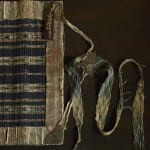Sutra Wrapper for the Jingoji-kyō
Sealed “Jingo-ji” on the lining
Mid to late 12th century
L30.9 x W41.7 cm
Further images
This wrapper is made of black-dyed thin bamboo sticks, bound by a number of color thread-braided cords and framed with a band of brocade with golden threads. The cords joined to the butterfly-shaped brass studs at upper and lower ends are relatively well preserved. The other side is covered by the green twilled silk with a rectangular Jingo-ji seal in red ink. That seal indicates the present work once served as protector of the Jingoji-kyo, a complete collection of Bugghist scriptures and decorative sutra scrolls, which was commissioned by the abdicated Emperor Toba, and later completed and donated to Jingo-ji Temple by the abdicated Emperor Go-Shirakawa. The “Mahayana sutra thirty-four” and “Bodhisattva ornaments, latter part of the ninth” are carved in gold on both sides of the rosewood tab tying with the stud. Based on it, the sutra protected by this wrapper is identified. It is said one wrapper was for a group of ten scrolls at a time and there were 439 pieces survived in the late Edo period. Yet, during the Meiji period, a huge amount of them have been dispersed over different collections: the Kyoto National Museum, the Nara National Museum, the Nezu Museum, the Hosomi Art Foundation, and unknown others. Today, Jingo-ji Temple still owns 202 pieces.
In terms of shape and structure, similar examples are seen in the Middle Section of Shoso-in Repository; whereas the decorative features, such as the mica-coated sheet beneath the bamboo and the Japanized silk brocade, point out that the work reflects the aesthetics of the late Heian period. Such an ambitious imperial commission not only focused on the transcript of the sutra itself, but spared no effort in making its protector in a lavish manner, revealing the rich flavor of the aristocratic grace of the time.
In terms of shape and structure, similar examples are seen in the Middle Section of Shoso-in Repository; whereas the decorative features, such as the mica-coated sheet beneath the bamboo and the Japanized silk brocade, point out that the work reflects the aesthetics of the late Heian period. Such an ambitious imperial commission not only focused on the transcript of the sutra itself, but spared no effort in making its protector in a lavish manner, revealing the rich flavor of the aristocratic grace of the time.







